Global Market Comments
February 13, 2023
Fiat Lux
Featured Trade:
(HOW CRISPR TECHNOLOGY MAY SAVE YOUR LIFE)
(TMO), (OVAS), (CLLS), (SGMO)

CLICK HERE to download today's position sheet.
Global Market Comments
February 13, 2023
Fiat Lux
Featured Trade:
(HOW CRISPR TECHNOLOGY MAY SAVE YOUR LIFE)
(TMO), (OVAS), (CLLS), (SGMO)

CLICK HERE to download today's position sheet.
When I was a DNA scientist at UCLA 50 years ago, the team used to slack off whenever our professor was attending an out-of-town conference.
We used to take pure 200 proof ethanol the university kept on hand “for research purposes,” used it to bring our beer up to 100 proof, and then speculate about the future of our obscure, neglected field.
With the technology at hand, we predicted it would take 3,000 years to fully decode the 3 billion base pairs of a length of human DNA. It then might take another 1,000 years to manipulate our genes to accomplish something useful, like curing cancer.
Maybe it was our “enhanced” beer talking, but we were off on our bold forecast by only 2,970 years.
Dr. Craig Venter published a map of his own DNA in 2001 using sophisticated algorithms to vastly accelerate our own snail-like progress.
The second step, that of functional genetic engineering, took only another decade instead of a millennium.
Clustered Regularly Interspaced Short Palindromic Repeats (CRISPR).
Memorize this term, write it in your diary, and put it on a post-it note on your computer.
It may save your life someday, if not add decades to your life. And it could also make you a multimillionaire if you play your cards right. More on that below.
And I count myself on becoming one of its fortunate users, once the technology goes retail, which should be soon.
If you are another DNA scientist, all I need to tell you is that CRISPR is used to manipulate segments of prokaryotic DNA containing short repetitions of base sequences.
Each repetition is followed by short segments of spacer DNA from previous exposures to a bacteriophage virus or plasmids. The protein fragments that identify and snip these crucial gene segments are called CRISPRs.
If you are the average Joe stock trader, which most of you are, suffice it to say that CRISPR technology is being developed that will enable you to edit your own DNA on a customized basis and then pass the changes on to your future generations.
This will eventually allow you to become immune to all diseases, increase your intelligence, and possibly live forever. Just cut out a bad gene and put in a new one and you and all your future decedents are fixed for good.
You only have to make it five or ten more years at the most with your current vintage DNA, and you can easily live another century.
Oh, and by the way, the company that successfully brings CRISPR products to market in an economical, cost affordable way should see its stock price rise tenfold, if not one hundredfold.
Interested?
Reading up on the research for this piece, one thought kept recurring in my mind: “I can’t believe they are already doing this NOW!”
CRISPR technology was first mooted by a Japanese researcher in 1987. It turns out that the Japanese have a huge head start in developing DNA technologies thanks to a 300-year track record in brewing potent rice wines, like sake.
By 2007, CRISPR went mainstream, attracting funding from a broad range of industries. There was initial heavy interest from the food producers, which sought to make plants and their seeds immune to common crop-destroying diseases.
Their work is partly responsible for the record crop yields that are presently crushing agricultural prices across the board.
As of today, there have been over 3,000 peer-reviewed papers published about CRISPR, each one taking us an infinitesimal step forward.
Currently, there are clinical trials underway employing CRISPR technology to fight multiple forms of cancer, herpes viruses, and advance immunosuppression in human organ transplants.
A legal battle broke out over who owns the rights to CRISPR technology, with Thermo Fisher Scientific (TMO) holdings several key patents.
OvaScience Inc. (OVAS) has started applying CRISPR to human embryos. It didn’t take long to ignite a firestorm of controversy over the prospect of permanently altering the human germline.
Will the wealthy buy their way into genetic superiority and immortality? Or will we accidentally create an organism that could wipe out the human race? Cries of “Social Darwinism” are everywhere.
Or worse, what if the Chinese make their own population immune to bioweapons which they then unleash on the rest of the world?
What if a gene treatment that cures cancer also makes individuals, aggressive, paranoid, or violent?
Talk about letting a genie out of a bottle while also opening Pandora’s Box!
Some leading scientific journals, like Nature and Science, have refused to publish some CRISPR paper over ethical concerns. Unsurprisingly, Chinese scientists have the lead in the most controversial applications.
It’s all way beyond my pay grade.
During my lifetime, I have seen science drop some real clangers.
While in Europe this summer, I saw a Thalidomide baby grown up, now in his fifties. The anti-morning sickness drug developed by a German company produced children with horrifying flippers instead of arms.
Even today, Thalidomide is held out as an example of the need for enhanced drug regulation in the US.
In the early 1950s, one doctor developed the bright idea of giving newborn babies pure oxygen. Everyone who received this treatment went completely blind for life.
And then the CIA developed LSD as a potential weapon, testing it on its own unwitting employees, who developed an unfortunate tendency to jump out of windows from high floors. We all know how that one worked out.
We already know what genes people will choose when given the opportunity to do so, instead of using the ones they inherited, the old-fashioned way.
The unregulated human artificial insemination industry makes available genotypes of every race and nationality in abundance. More than 90% choose tall, blonde, intelligent donors, inadvertently creating a financial windfall from the UC Berkeley Men’s Water Polo Team.
It is an outcome Adolph Hitler would have been proud of, as more than 1 million of these children have been born in the US alone.
Some prolific water polo players have sired more than 100 children, which are now using websites like 23andMe and Ancestry.com to find each other and socialize.
It was not in the game plan.
As is always the case with new, cutting edge, groundbreaking technologies, it is hard to find a rifle shot investment that gives you a pure play.
Many such efforts are subsumed inside huge companies where a specific technology never moves the needle. Starts ups often go bust because they can’t keep up with rapidly evolving technology.
That’s what happened to the 3D printing industry, and I can’t remember how many hard drive companies and PC makers that have gone under.
Editas (EDIT), Caribou Biosciences (CRBU), Intellia (NTLA), CRISPR Therapeutics (CRSP), and Precision Biosciences (DTIL) have all gone public over the last five years. Here is your bite of the apple.
Cellectis (CLLS) is a $1.1 billion French company that is involved in both gene editing and cancer immunotherapy. The Company has improved the quality of crops for the food and agriculture industries.
And here is the really good news.
Many of these shares have dropped 70%-80% in the last year, thanks to the generalized biotech meltdown and the wholesale flight from profitless companies. Crisper alone fell 77% top to bottom, much to my own personal financial destruction.
Many will find the prospect of living another century enticing. I might be interested if I could get back the body I has when I was 25 but still know what I know now.
The possibility of finding a stock that could rise 10 or 100 times is MUCH more interesting.

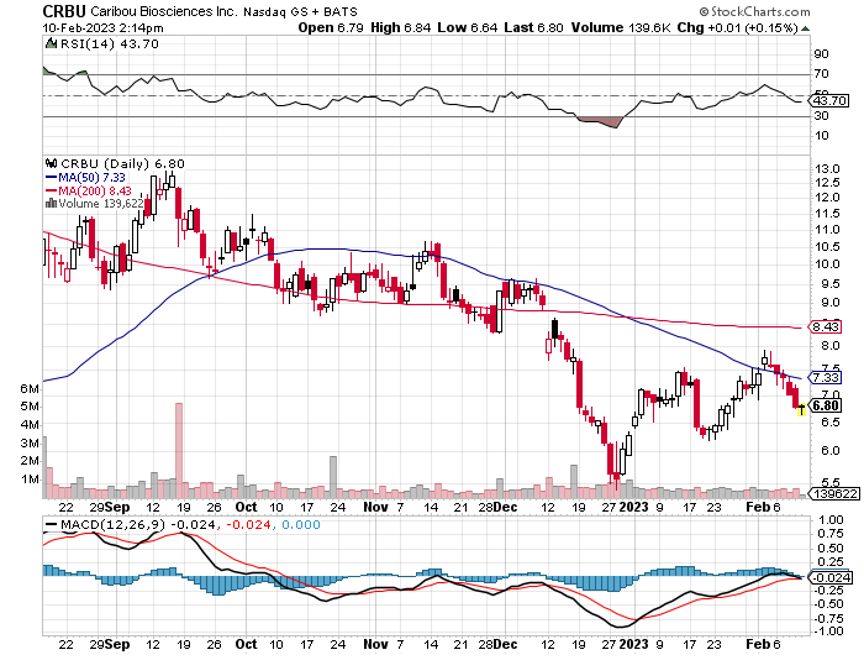
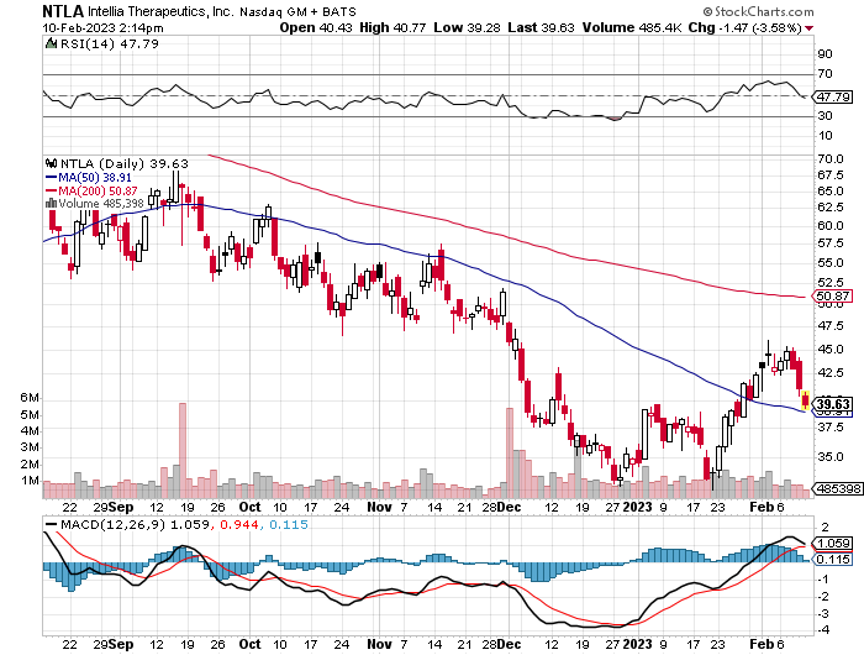
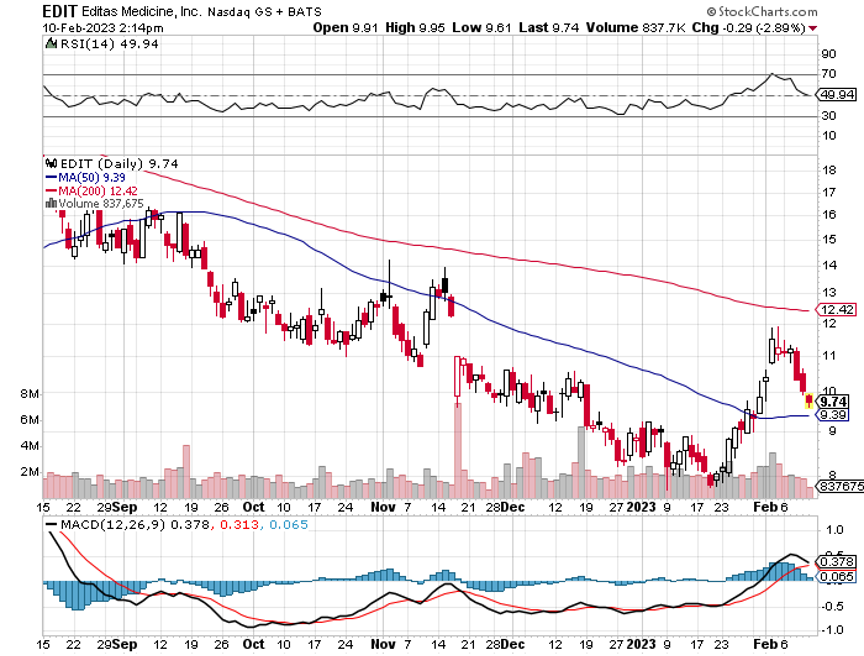
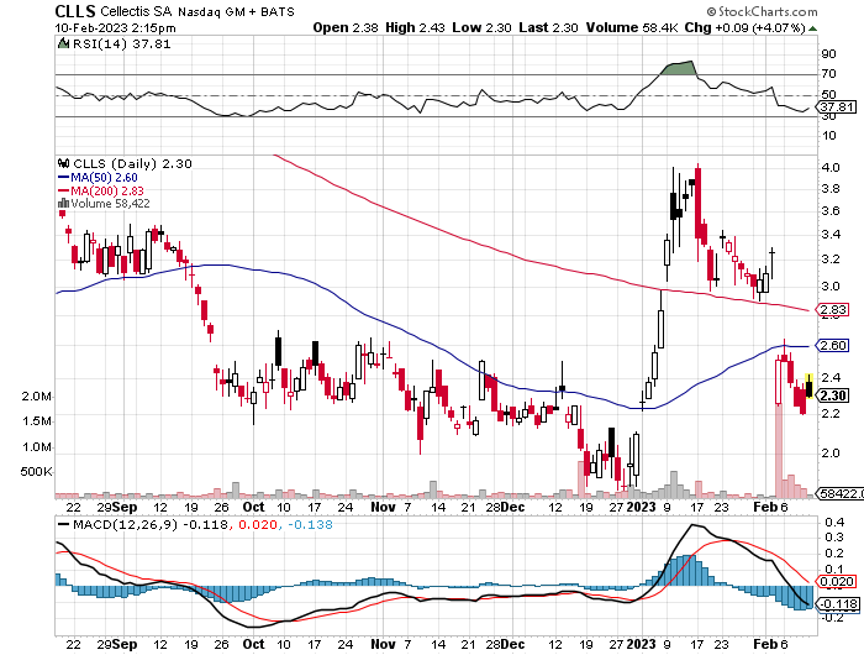
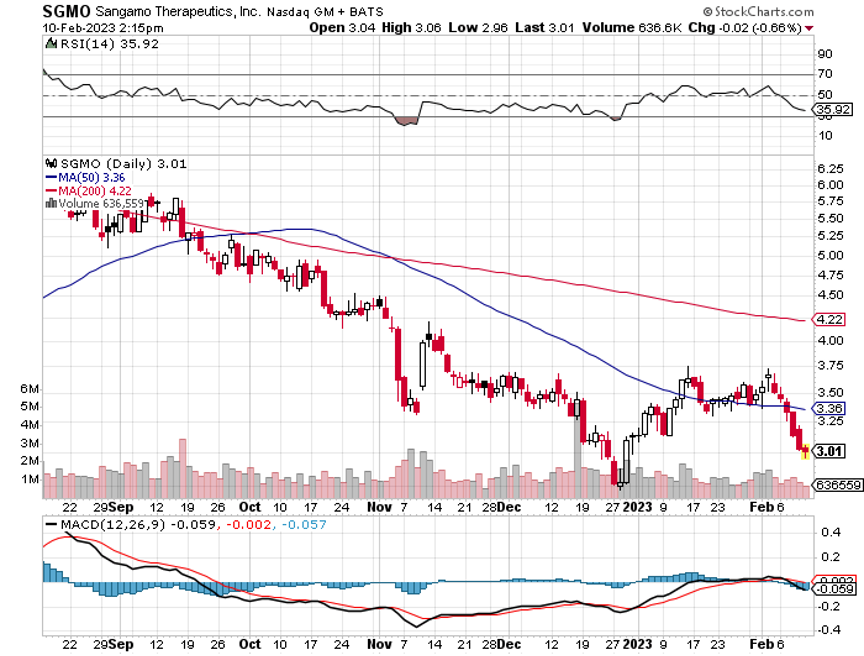
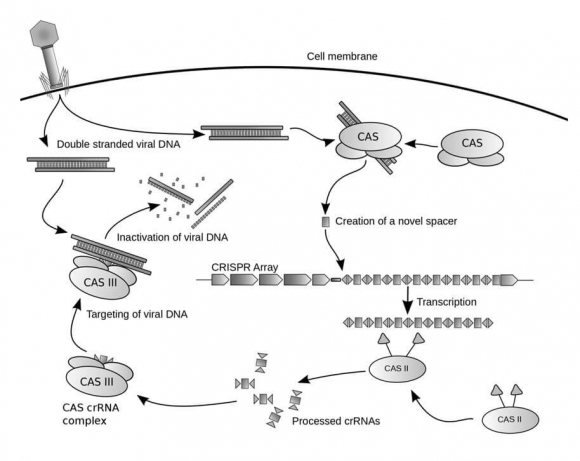
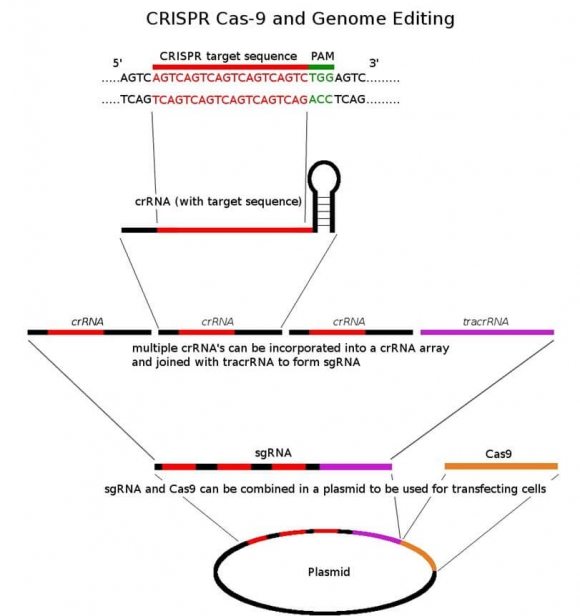

Putting Another 100 Years on the Clock?
Global Market Comments
April 6, 2022
Fiat Lux
SPECIAL CRISPR TECHNOLOGY ISSUE
Featured Trade:
(HOW CRISPR TECHNOLOGY MAY SAVE YOUR LIFE),
(TMO), (OVAS), (CLLS), (SGMO)

Mad Hedge Biotech and Healthcare Letter
February 15, 2022
Fiat Lux
Featured Trade:
(AN EMERGING LEADER IN THE HEALTHCARE REVOLUTION)
(CRSP), (VRTX), (EDIT), (NTLA), (PFE), (NVS), (GILD), (RHHBY), (BMRN), (QURE), (SGMO), (CLLS), (ALLO), (BEAM)

Mankind has always imagined a future filled to the brim with technological advancements serving as the panacea to all our ills.
One of the prevailing ideas focuses on the developments found in the healthcare sector.
Movies, television shows, graphic novels, and books have all pictured a world with such revolutionary technologies capable of not only diagnosing but also curing any and all types of diseases.
Since the introduction of these ideas, many have believed that these would remain in the fictional universe. However, these “ideas” have slowly transformed into reality.
One of the biggest indicators that we’re heading in that direction is the 2020 Nobel Prize in Chemistry by Jennifer Doudna and Emmanuelle Charpentier. The two were recognized for their pioneering work in CRISPR-Cas9.
Basically, Crispr-Cas9 functions like molecular scissors.
What makes this technology incredible is that Crispr-Cas9 can classify a single address out of 3 billion letters within the genome by using only a particular sequence. With this, we can repair thousands of genetic conditions and even offer more potent ways to battle cancer.
This Nobel Prize led to commercializing the 2012 discovery, Crispr-Cas9, at breakneck speed, with gene-editing companies like CRISPR Therapeutics (CRSP), Editas Medicine (EDIT), and Intellia Therapeutics (NTLA) gaining a considerable boost in their values.
Surprisingly, the trajectory of these gene-editing stocks took a tragic turn in 2021.
In fact, the once-upon-a-time-market-darling CRISPR Therapeutics saw its market capitalization brutally shaved off from $8.7 billion to $4.55 billion in the past months.
No matter how we look at it, there’s genuinely no way to sugarcoat the reality: the market has been second-guessing CRISPR Therapeutics’ ability to truly deliver on its promise.
That is, investors have started to wonder whether the company’s early stage success would amount to anything commercially.
CRISPR Therapeutics is currently working on a treatment that would implant tumor-targeting immune cells on cancer patients. The company is also prioritizing therapies that could edit cells to treat diabetes.
So far, it has made significant progress in developing treatments for a genetic disorder called sickle cell.
In the US alone, at least 100,000 people suffer from sickle cell disease, with 4,000 more born every year. Conservatively, we can estimate at least 3,000 patients availing of this one-time treatment at over $1.6 million a pop.
To date, CRISPR Therapeutics has five candidates under clinical trials for diseases like B-thalassemia, sickle cell disease, and other regenerative conditions.
It has four more queued, which target diabetes, cystic fibrosis, and Duchenne muscular dystrophy.
Compared to its rivals in the space, it’s clear that CRISPR Therapeutics is ahead when it comes to product development and trials.
Two of its candidates, transfusion-dependent beta thalassemia treatment CTX001 and sickle cell disease therapy CTX110, have already been submitted for clinical tests for safety and efficacy.
Recently, Vertex (VRTX) boosted its 2015 agreement with CRISPR Therapeutics by 10%, with the deal reaching $900 million upfront to push for quicker results in developing CTX001.
This is a crucial move for Vertex, but more so for CRISPR Therapeutics as CTX001 holds a highly lucrative addressable market.
The additional funding significantly widened the gap between the Vertex-CRISPR team and bluebird bio (BLUE) in the race to launch a new gene-editing therapy targeting sickle cell disease and beta thalassemia.
To sustain its growth, CRISPR Therapeutics’ strategy is to develop drugs that only require mid-level complexity but can rake in generous financial rewards.
This is a similar tactic used by bigger and more established biotechnology companies like Pfizer (PFE), Novartis (NVS), and Gilead Sciences (GILD).
Evidently, this strategy is a great way to ensure cash flow.
Aside from its earnings from the commercialization of these products, CRISPR Therapeutics can also attract larger companies to buy the intellectual property of their breakthrough treatments.
After all, startups generally get 100% premiums in contracts with Big Pharma.
Good examples of this are Novartis that bought AveXis and Roche’s (RHHBY) purchase of Spark Therapeutics.
The Roche-Spark agreement led to the first ever FDA-approved treatment since gene therapy trials started in the 1990s. It was for the genetic blindness therapy Luxturna, which received the green light in 2017.
The second approved treatment was a muscle-wasting disease therapy Zolgensma, which was the fruit of the Novartis-Avexis acquisition.
Both conditions are rare, but the financial rewards are impressive.
At $2 million for each treatment, Zolgensma sales reached $1.2 billion annually. At the rate the therapy is selling, Novartis estimates that Zolgensma will surpass the $2 billion mark in 2021.
Novartis and Roche aren’t the only ones partnering with smaller gene editing companies.
Pfizer has been working with biotechnology companies BioMarin Pharmaceutics (BMRN) and UniQure (QURE) to develop a treatment for blood-clotting disorder hemophilia.
The COVID-19 frontrunner is also collaborating with Sarepta Therapeutics (SRPT) to come up with a treatment for Duchenne muscular dystrophy.
Gene editing has also served as the foundation for several biotechnology companies out there today like Sangamo Therapeutics (SGMO), Cellectis (CLLS), and Allogene Therapeutics (ALLO).
The market size for gene editing treatments is estimated to be worth $11.2 billion by 2025, with the number rising between $15.79 billion to $18.1 billion by 2027.
This puts the compounded annual growth rate of this sector to be at least roughly 17%.
While this is already groundbreaking with only a handful of companies knowing how to utilize the technology, the gene-editing world has come up with a more advanced technique than Crispr-Cas9.
The technology is founded on the “base editing” or “prime editing” technique, which is the simplest type of gene editing that alters only one DNA letter.
So far, one company holds exclusive rights to this technology: Beam Therapeutics (BEAM).
When the technology became public, Beam stock has increased sixfold since its IPO in February 2020.
This latest development can resolve thousands of genetic diseases. However, it still requires further trials since “base editing” can also trigger damaging responses from the body.
Overall, I think CRISPR Therapeutics is the most promising among these high-risk stocks.
The data from two of its candidates, CTX001 and CTX110, are promising. The added funding from Vertex boosts the confidence of investors that a regulatory approval is well on its way.
The company is also sitting on a massive cash pile and investing aggressively across different rare disease programs.
While the company has yet to be considered a major force in the biotechnology world, the potential multiple successes of its products could generate a company worth hundreds of billions.
This potential alone offers an investing opportunity with a substantial asymmetric advantage for its current share price.
However, bear in mind that the stock is not for conservative investors considering risks.
More importantly, its pipeline requires patience. Hence, CRISPR Therapeutics should be played as a long-term investment.
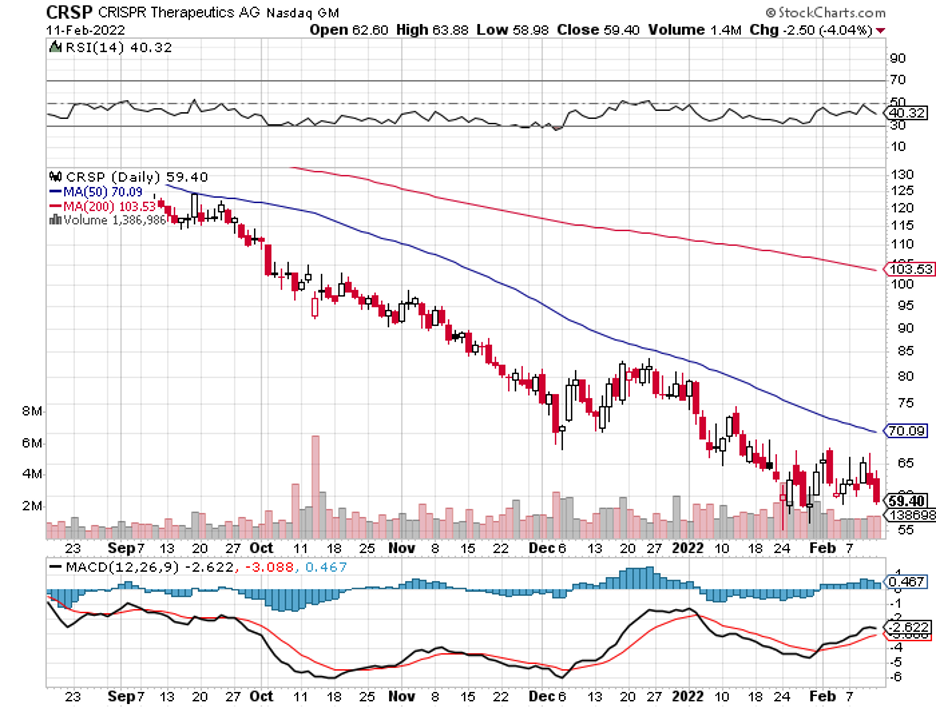
Mad Hedge Biotech & Healthcare Letter
April 27, 2021
Fiat Lux
FEATURED TRADE:
(THE FUTURE OF MEDICINE)
(CRSP), (VRTX), (EDIT), (NTLA), (PFE), (NVS), (GILD), (RHHBY),
(BMRN), (QURE), (SGMO), (CLLS), (ALLO), (BEAM)

Winning the Nobel Prize in 2020 provided biotechnology companies more traction on Wall Street.
The victory led to commercializing the 2012 discovery, Crispr-Cas9, at breakneck speed, with gene editing companies like CRISPR Therapeutics (CRSP), Editas Medicine (EDIT), and Intellia Therapeutics (NTLA) gaining considerable boost in their values.
Since then, the total market value for the products of these three has more than doubled in recent months to reach $23 billion.
Basically, Crispr-Cas9 functions like molecular scissors.
What makes this technology incredible is that Crispr-Cas9 can classify a single address out of 3 billion letters within the genome by using only a particular sequence. With this, we can repair thousands of genetic conditions and even offer more potent ways to battle cancer.
The market favorite among the gene editing companies so far is CRISPR Therapeutics, with $8.72 billion in market capitalization.
In comparison, Editas has $2.76 billion while Intellia Therapeutics has $4.15 billion.
CRISPR Therapeutics is currently working on a treatment that would implant tumor-targeting immune cells in cancer patients. The company is also prioritizing therapies that could edit cells to treat diabetes.
So far, it has made significant progress in developing treatments for a genetic disorder called sickle cell.
In the US alone, at least 100,000 people suffer from sickle cell disease, with 4,000 more born every year. Conservatively, we can estimate at least 3,000 patients availing of this one-time treatment at over $1.6 million a pop.
To date, CRISPR Therapeutics has five candidates under clinical trials for diseases like B-thalassemia, sickle cell disease, and other regenerative conditions.
It has four more queued, which target diabetes, cystic fibrosis, and Duchenne muscular dystrophy.
Compared to its rivals in the space, it’s clear that CRISPR Therapeutics is ahead when it comes to product development and trials.
Two of its candidates, transfusion-dependent beta thalassemia treatment CTX001 and sickle cell disease therapy CTX110, have already been submitted for clinical tests for safety and efficacy.
Recently, Vertex (VRTX) boosted its 2015 agreement with CRISPR Therapeutics by 10%, with the deal reaching $900 million upfront to push for quicker results in developing CTX001.
This is a crucial move for Vertex, but more so for CRISPR Therapeutics as CTX001 holds a highly lucrative addressable market.
The additional funding significantly widened the gap between the Vertex-CRISPR team and bluebird bio (BLUE) in the race to launch a new gene editing therapy targeting sickle cell disease and beta thalassemia.
To sustain its growth, CRISPR Therapeutics’ strategy is to develop drugs that only require mid-level complexity but can rake in generous financial rewards.
This is a similar tactic used by bigger and more established biotechnology companies like Pfizer (PFE), Novartis (NVS), and Gilead Sciences (GILD).
Evidently, this strategy is a great way to ensure cash flow.
Aside from its earning from the commercialization of these products, CRISPR Therapeutics can also attract larger companies to buy the intellectual property of their breakthrough treatments.
After all, startups generally get 100% premiums in contracts with Big Pharma.
Good examples of this are Novartis that bought AveXis and Roche’s (RHHBY) purchase of Spark Therapeutics.
The Roche-Spark agreement led to the first-ever FDA-approved treatment since gene therapy trials started in the 1990s. It was for the genetic blindness therapy Luxturna, which received the green light in 2017.
The second approved treatment was a muscle-wasting disease therapy Zolgensma, which was the fruit of the Novartis-Avexis acquisition.
Both conditions are rare, but the financial rewards are impressive.
At $2 million for each treatment, Zolgensma sales reached $1.2 billion annually. At the rate the therapy is selling, Novartis estimates that Zolgensma will surpass the $2 billion mark in 2021.
Novartis and Roche aren’t the only ones partnering with smaller gene editing companies.
Pfizer has been working with biotechnology companies BioMarin Pharmaceutics (BMRN) and UniQure (QURE) to develop a treatment for blood-clotting disorder hemophilia.
The COVID-19 frontrunner is also collaborating with Sarepta Therapeutics (SRPT) to come up with a treatment for Duchenne muscular dystrophy.
Gene editing has also served as the foundation for several biotechnology companies out there today like Sangamo Therapeutics (SGMO), Cellectis (CLLS), and Allogene Therapeutics (ALLO).
The market size for gene editing treatments is estimated to be worth $11.2 billion by 2025, with the number rising between $15.79 billion to $18.1 billion by 2027.
This puts the compounded annual growth rate of this sector to be at least roughly 17%.
While this is already groundbreaking with only a handful of companies knowing how to utilize the technology, the gene editing world has come up with a more advanced technique than Crispr-Cas9.
The technology is founded on the “base editing” or “prime editing” technique, which is the simplest type of gene editing that alters only one DNA letter.
So far, one company holds exclusive rights to this technology: Beam Therapeutics (BEAM).
When the technology became public, Beam stock has increased sixfold since its IPO in February 2020.
This latest development can resolve thousands of genetic diseases. However, it still requires further trials since “base editing” can also trigger damaging responses from the body.
Overall, I think CRISPR Therapeutics is the safest among these high-risk stocks.
The data from two of its candidates, CTX001 and CTX110, are incredibly promising. Plus, the added funding from Vertex boosts the confidence of investors that regulatory approval is well on its way.
The company is also capitalizing on the surging price of its stock and investing aggressively across different rare disease programs.
While the company has yet to be considered a major force in the biotechnology world, the potential multiple successes of its products could generate a company worth hundreds of billions.
This potential alone offers an investing opportunity with a substantial asymmetric advantage for its current share price.
However, bear in mind that the stock is still a risk and should be played as a long-term investment. Hence, you should buy on dips.
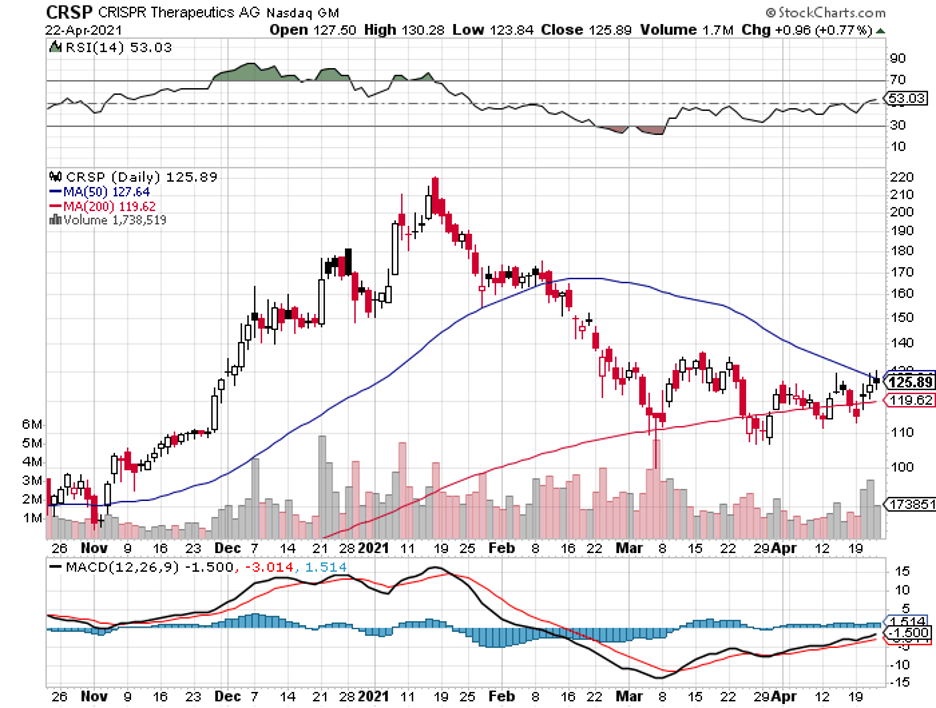
Global Market Comments
May 3, 2019
Fiat Lux
Featured Trade:
(LAST CHANCE TO ATTEND THE LAS VEGAS MAY 9 GLOBAL STRATEGY LUNCHEON)
(APRIL 3 BIWEEKLY STRATEGY WEBINAR Q&A),
(SPY), (LYFT), (TSLA), (TLT), (XLV), (UBER),
(AAPL), (AMZN), (MSFT), (EDIT), (SGMO), (CLLS)

Below please find subscribers’ Q&A for the Mad Hedge Fund Trader May 1 Global Strategy Webinar with my guest and co-host Bill Davis of the Mad Day Trader. Keep those questions coming!
Q: Your old target for the (SPY) was $292.80; we’re clearly above that now. What’s your new target and how long will it take to get there?
A: My new target on the S&P 500 (SPY) is $296.80. You’re looking at $295 on the (SPY), so we’re almost there. However, we’re grinding up too slowly so I can’t give you an exact date.
Q: Will Fed governor Jay Powell give in to pressure from Trump who wants him to drop rates? Does he have any sway over the process?
A: Officially he has no sway, but every day Trump is tweeting: “I want QE back, I want a 1% rate cut.” And if that happened, the economy would completely blow up—an interest rate cut with the market at an all-time high and 3.25% GDP growth rate would be unprecedented, would deliver a short term gain and long term disaster.
Q: What do you think about the Uber (UBER) IPO?
A: I wouldn’t touch it with a 10-foot pole—they’ve been cutting valuations almost every day. At one point they were going to value the company at $120 billion dollars, now they’re at $90 billion and they may even lower it from there. The last car sharing IPO (LYFT) dropped 33% from its high. I would stay away from all of the IPOs once they’re listed. The rule is: only buy these things when they’re down 50%. Warren Buffet never buys IPOs, nor do I.
Q: What do you think about buying or selling Lyft?
A: I would wait a couple of months for Lyft to find its true price. Then you’ll have something to trade against.
Q: Do you think the bad news is over on Tesla (TSLA)? Is it time to buy? Or is it going bankrupt?
A: The whole world knew that the electric car subsidy would be cut in January, so what customers did was accelerate their orders in the 4th quarter, which took us all the way up to $380 in the shares, and then created a vacuum in the Q1 of this year. It reported the first quarter last week—they were disastrous orders, and the company is cutting back overhead as fast as possible as if it’s going into a recession, which it kind of is. The question is whether or not sales will bounce back in Q2 with the smaller subsidy. I happen to think they will. But we may not see 2018 Q4 sales levels again until 2019 Q4.
Q: Why has healthcare (XLV) been so awful this year?
A: There’s an election next year and both parties promise to beat up on the healthcare industry with drug control pricing and other forms of regulation. Of course, the current president promised free competition in drug prices; but then he moved to Washington DC and found the drug industry lobby, and nothing was ever heard again on that front. It’s a very high political risk sector, but there is some great value at these levels in the healthcare industry in the long term. I’m about to start the Mad Hedge Biotech and Health Care newsletter imminently.
Q: Should I buy the (TLT) $120-$123 call spread now?
A: That's a very aggressive trade, I would wait and go with strikes for in the money, and then only on a big dip. Don’t reach for a trade when the market is at an all-time high.
Q: Should I be shorting Tesla down here?
A: Absolutely not, your short trade was at $380, $350, $330 and $300. Down here, you run the risk of a surprise tweet from Elon Musk causing the stock to go $50 against you. Buy the way, he’s already announced that he’s buying $10 million worth of shares in his next capital raise.
Q: What do you think about CRISPR stocks long term, like Editas Medicine (EDIT), Sangamo Life Sciences (SGMO), and Cellectis (CLLS)?
A: These are probably the best bunch of 10 baggers long term. Short term they are afflicted with the same problems impacting all of healthcare—promises of regulation and price control on all of their products ahead of an election. So, hold for the long term; short term I’d only be buying the really big dips. Did I mention that I’m about to start the Mad Hedge Biotech and Health Care newsletter imminently?
Q: Is your May 10th market top forecast still good?
A: Well we’re getting kind of close to May 10th. I made this prediction based on an inverting yield curve two years ago. However, that target did not anticipate interest rates topping out for the 10-year US Treasury bond at 3.25%. Nor did it consider the Fed canceling all interest rate hikes for the year. Without the artificial stimulus, the market would certainly have already rolled over and died. That said, I still have a week to go.
Q: Should I be selling my long term holds in the FANGS, like Apple (AAPL), Amazon (AMZN), and Microsoft (MSFT)?
A: For the long term, no. However, we know from December that these things can get hit with a 40% drawdown at any time. As long as you can handle that, they always bounce back.
Q: What will happen to Venezuela? Any trades?
A: The only related trades would be in the oil market (USO). If we get a coup d’ etat which installs a new pro-American president, which could be at any time, that could lead to a selloff in oil for a couple of days as 1 Million barrels of crude per day come back on the market, but probably no more than that.
Q: With current national debt and budget deficits, when will interest in gold kick in?
A: Very simple: when the stock market goes down, you want to buy gold. It’s the hedge that everyone will chase after, and inflation is just around the corner.
Q: Do you need me to place any Kentucky Derby bets?
A: Me being the cautious guy I am, I pick the horse with the best odds and then I bet him to show. That almost always works.
Q: What about pot stocks?
A: I’ve never liked them very much; after all, how hard is it to grow a weed? The barriers to entry are zero. All of these pot companies coming up now are not really pot stocks as much as they are marketing companies, so you’re buying their distribution capability primarily. That said, I’m having breakfast with the CEO of a major pot company next week, so I’ll be writing about that once I get the inside scoop.
Q: Will the Fed be the non-event?
A: Yes, as stated in the Mad Hedge Hot Tips this morning, it will be a non-event and the news is due out in about an hour.
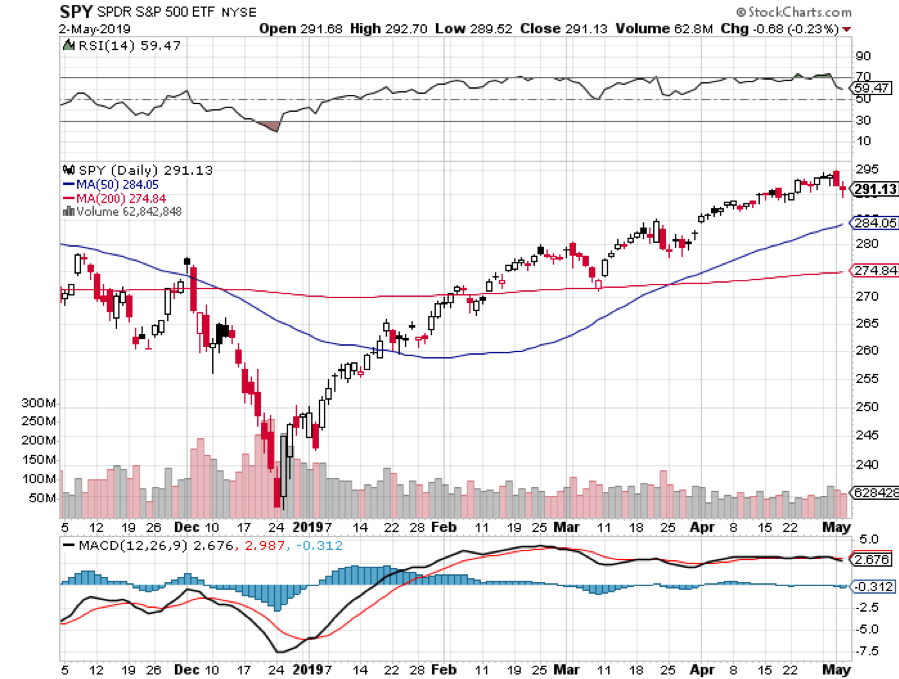
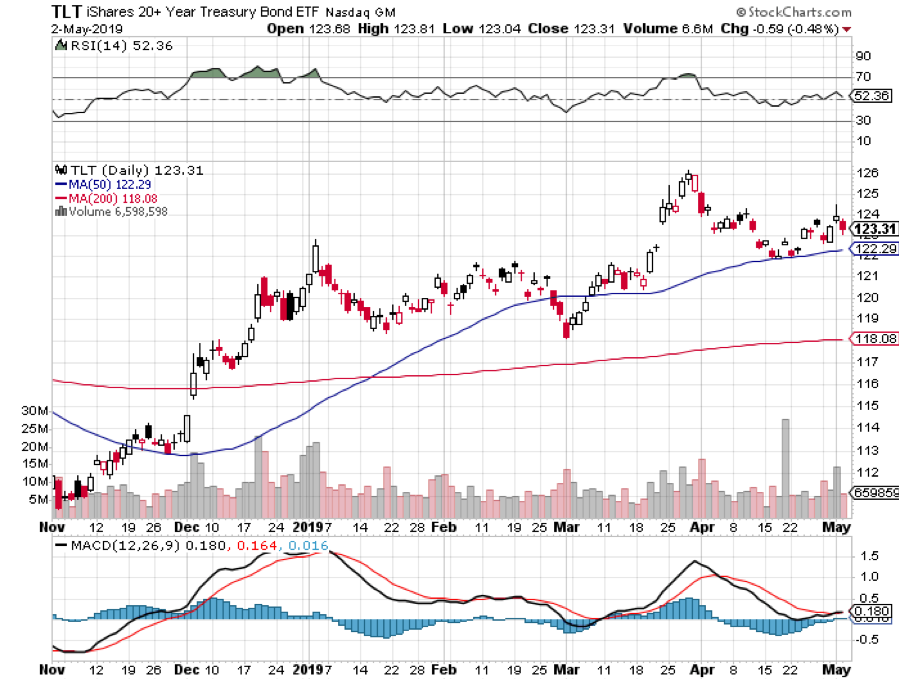

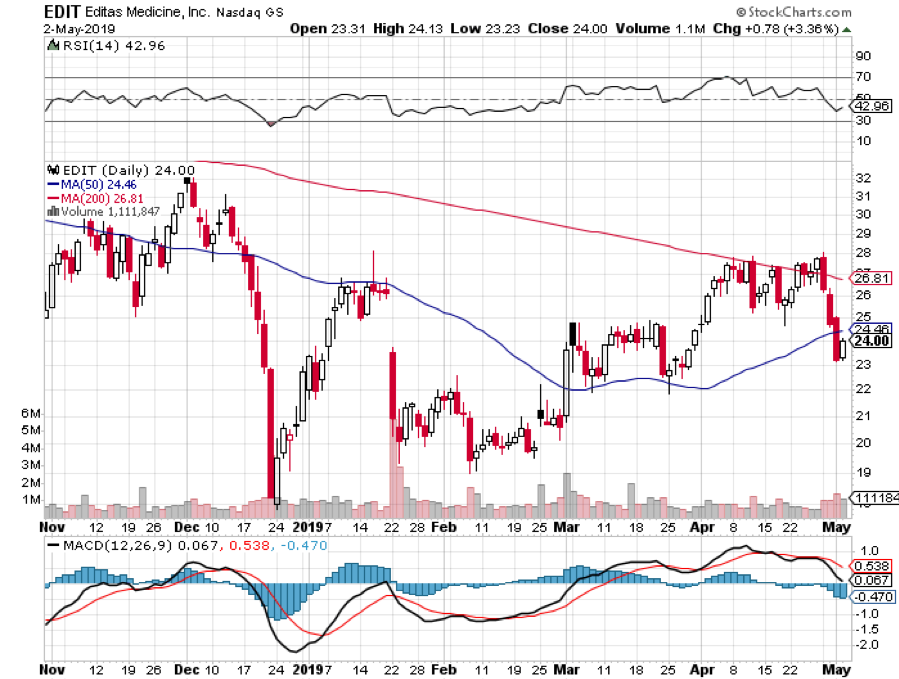

Legal Disclaimer
There is a very high degree of risk involved in trading. Past results are not indicative of future returns. MadHedgeFundTrader.com and all individuals affiliated with this site assume no responsibilities for your trading and investment results. The indicators, strategies, columns, articles and all other features are for educational purposes only and should not be construed as investment advice. Information for futures trading observations are obtained from sources believed to be reliable, but we do not warrant its completeness or accuracy, or warrant any results from the use of the information. Your use of the trading observations is entirely at your own risk and it is your sole responsibility to evaluate the accuracy, completeness and usefulness of the information. You must assess the risk of any trade with your broker and make your own independent decisions regarding any securities mentioned herein. Affiliates of MadHedgeFundTrader.com may have a position or effect transactions in the securities described herein (or options thereon) and/or otherwise employ trading strategies that may be consistent or inconsistent with the provided strategies.
This site uses cookies. By continuing to browse the site, you are agreeing to our use of cookies.
OKLearn moreWe may request cookies to be set on your device. We use cookies to let us know when you visit our websites, how you interact with us, to enrich your user experience, and to customize your relationship with our website.
Click on the different category headings to find out more. You can also change some of your preferences. Note that blocking some types of cookies may impact your experience on our websites and the services we are able to offer.
These cookies are strictly necessary to provide you with services available through our website and to use some of its features.
Because these cookies are strictly necessary to deliver the website, refuseing them will have impact how our site functions. You always can block or delete cookies by changing your browser settings and force blocking all cookies on this website. But this will always prompt you to accept/refuse cookies when revisiting our site.
We fully respect if you want to refuse cookies but to avoid asking you again and again kindly allow us to store a cookie for that. You are free to opt out any time or opt in for other cookies to get a better experience. If you refuse cookies we will remove all set cookies in our domain.
We provide you with a list of stored cookies on your computer in our domain so you can check what we stored. Due to security reasons we are not able to show or modify cookies from other domains. You can check these in your browser security settings.
These cookies collect information that is used either in aggregate form to help us understand how our website is being used or how effective our marketing campaigns are, or to help us customize our website and application for you in order to enhance your experience.
If you do not want that we track your visist to our site you can disable tracking in your browser here:
We also use different external services like Google Webfonts, Google Maps, and external Video providers. Since these providers may collect personal data like your IP address we allow you to block them here. Please be aware that this might heavily reduce the functionality and appearance of our site. Changes will take effect once you reload the page.
Google Webfont Settings:
Google Map Settings:
Vimeo and Youtube video embeds:
